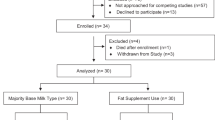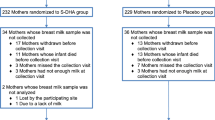Abstract
Objective: To review briefly the influence of dietary long-chain polyunsaturated fatty acids (LC-PUFA) on tissue composition and functionality in early infancy. Moreover, the influences of LC-PUFA sources on plasma composition as well as the effects of these fatty acids on intestinal repair after malnutrition are discussed.
Results: Human milk not only supplies essential fatty acids but also contains up to 2% of the total fatty acids as LC-PUFA, of which arachidonic acid (AA) and docosahexaenoic acid (DHA) are considered the most important. Plasma and erythrocyte levels of both AA and DHA are decreased in infants fed artificial standard milk formulae. However, the supplementation of formulae with these fatty acids in amounts close to that of human milk leads to tissue LC-PUFA patterns similar to those of breast-fed infants. However, the bioavailability of LC-PUFA depends on the typical LC-PUFA source; egg phospholipids increases both AA and DHA in plasma phospholipids and HDL more than a mixture of tuna and fungal triglycerides.
Conclusions: Dietary LC-PUFA affects positively the growth and development of the infant and ameliorates the visual and cognitive functions, particularly in preterm infants. Likewise, LC-PUFA improves intestinal repair in severe protein-energy malnutrition; therefore, its qualitative and quantitative dietary supply should be considered.
This is a preview of subscription content, access via your institution
Access options
Subscribe to this journal
Receive 12 print issues and online access
$259.00 per year
only $21.58 per issue
Buy this article
- Purchase on Springer Link
- Instant access to full article PDF
Prices may be subject to local taxes which are calculated during checkout


Similar content being viewed by others
References
Agostoni C, Trojan S, Bellú R, Riva E, Bruzzese MG & Giovannini M (1997): Developmental quotient at 24 months and fatty acid composition of diet in early infancy: a follow up study. Arch. Dis. Child. 76, 421–424.
Amate L, Gil A & Ramírez M (2001): Lipid and fatty acid composition of plasma, plasma lipoproteins, liver and jejunum in feeding infant piglets with long-chain polyunsaturated fatty acids as triacylglycerols or phospholipids influences the distribution of these fatty acids in plasma lipoprotein fractions. J. Nutr. 131, 1250–1255.
Birch EE, Garfield S, Hoffman Dr, Uauy R & Birch DG (2000): A randomized controlled trial of early dietary supply of long-chain polyunsaturated fatty acids and mental development in term infants. Dev. Med. Child. Neurol. 42, 174–181.
Carlson SE, Werkman SH, Peeples JM, Cooke RJ & Tolley EA (1993): Arachidonic acid status correlates with first year growth in preterm infants. Proc. Natl. Acad. Sci. USA 90, 1073–1077.
Commission of European Community (CEE) (1996): Directive 96/4/CE 16th February modifying the Directive 91/321/CEE on formulas and foostuffs intended for infants. DOCE Brussels No. L 49/12–16.
Decsi T, Kelemen B, Minda H, Burus I & Kohn G (2000): Effect of type of early infant feeding on fatty acid composition of plasma lipid classes in full term infants during the second 6 months of life. J. Pediatr. Gastroenterol. Nutr. 30, 547–551.
Decsi T & Koletzko B (1995): Growth, fatty acid composition of plasma lipid classes, and plasma alpha-tocopherol concentrations in full term infants fed formula enriched in omega-6 and omega3 long-chain polyunsaturated fatty acids. Acta Paediatr. 84, 725–732.
Demmelmair H, Von Schenck U, Behrendt E, Sauerwald T & Koletzko B (1995): Estimation of arachidonic acid synthesis in full term neonates using natural variation of 13C content. J. Pediatr. Gastroenterol. Nutr. 21, 31–36.
ESPGHAN Committee on Nutrition. Committee Report (1991): Aggett PJ, Haschke F, Heine W, Hernell O, Koletzko B, Launiala K, Rey J, Rubino A, Schöch G, Senterre J, Tormo R. Comment on the content and composition of lipids in infant formulas. Acta Paediatr. Scand. 80, 887–896.
Farquharson J, Jamieson EC, Logan RW, Patrick WA, Howatson AG & Cockburn F (1995): Age- and dietary-related distributions of hepatic arachidonic and docosahexaenoic acid in early infancy. Pediatr. Res. 38, 361–365.
Forsyth JS, Willats P, DiModugno MK, Varma S & Colvin M (1996): Do long chain polyunsaturated fatty acids influence infant cognitive behavior? In Recent Developments in Infant Nutrition, eds, JG Bindels, A Goedhart, HKA Visser, pp 225–234. Lancaster, UK: Kluwer Academic Publishers.
Heird WC, Prager TC & Anderson RE (1997): Docosahexaenoic acid and the development and function of the infant retina. Current Opinion Lipidol. 8, 12–16.
Hoffman DR, Birch EE, Birch DG & Uauy RD (1993): Effects of supplementation with w3 long-chain polyunsaturated fatty acids on retinal and cortical development in premature infants. Am. J. Clin. Nutr. 57, 807–812.
Jensen RG (1999): Lipids in human milk. Lipids 34, 1243–1271.
Koletzko B, Thiel I & Abiodum PO (1992): The fatty acid composition of human milk in Europe and Africa. J. Pediatr. 120, S62–S70.
López-Pedrosa JM, Ramírez M, Torres MI & Gil A (1999): Dietary phospholipids rich in long-chain polyunsaturated fatty acids improve the repair of small of intestine in previously malnourished piglets. J. Nutr. 129, 1149–1155.
Mayer DL & Dobson V (1997): Grating acuity cards: validity and reliability in studies of human visual development. In Developing Brain and Behaviour: the Role of Lipids in Infant Formulas, ed. J Dobbing, pp 253–288. London: Academic Press.
Neuringer M (2000): Infant vision and retinal function in studies of dietary long-chain polyunsaturated fatty acids: methods, results, and implications. Am. J. Clin. Nutr. 71(suppl), 256S–2567S.
Pita ML, Girón MD, Pérez-Ayala M, DeLucchi C, Martínez-Valverde A & Gil A (1989): effects of postnatal age and diet on plasma lipid fractions in preterm infants. Clin. Physiol. Biochem. 7, 238–248.
Ramírez M, Maldonado J, García-Salmerón JL, Narbona E & Gil A . (1988): Plasma and red blood cell fatty acid composition in small for gestational age term infants fed human milk or formula. Clin. Nutr. 17, 177–183.
Uauy R, Mena P, Wegher B, Nieto S & Salem N (2000): Long chain polyunsaturated fatty acid formation in neonates: Effect of gestational age and intrauterine growth. Pediatr. Res. 47, 127–235.
Willatts P, Forsyth JS, DiModugno MK, Varma S & Colvin M (1998): Effect of long-chain polyunsaturated fatty acids in infant formula on problem solving at 10 months of age. Lancet 352, 688–691.
Author information
Authors and Affiliations
Contributions
Guarantor: A Gil.
Contributors: AG was the main person responsible for designing and conducting the experimental studies as well as the main contributor in writing the manuscript. MR was working in the lab and obtained a significant part of the experimental data. She has also been involved in writing the manuscript. MG, as a paediatrician, has reviewed all the clinical data related to the role of PUFA in infancy and has also contributed in writing the manuscript.
Corresponding author
Rights and permissions
About this article
Cite this article
Gil, A., Ramirez, M. & Gil, M. Role of long-chain polyunsaturated fatty acids in infant nutrition. Eur J Clin Nutr 57 (Suppl 1), S31–S34 (2003). https://doi.org/10.1038/sj.ejcn.1601810
Published:
Issue Date:
DOI: https://doi.org/10.1038/sj.ejcn.1601810
Keywords
This article is cited by
-
Progress and perspectives of enzymatic preparation of human milk fat substitutes
Biotechnology for Biofuels and Bioproducts (2022)
-
Beta-palmitate – a natural component of human milk in supplemental milk formulas
Nutrition Journal (2015)
-
Destabilization of Egg Yolk Emulsion After IgY Removal Through Enzymatic Treatments
Journal of the American Oil Chemists' Society (2014)
-
Effect of different dietary omega-3/omega-6 fatty acid ratios on reproduction in male rats
Lipids in Health and Disease (2013)
-
n-3 polyunsaturated fatty acids in milk is associate to weight gain and growth in premature infants
Lipids in Health and Disease (2009)



